A place of refuge?
Squalid and overcrowded – we visit one of the largest refugee camps in Greece
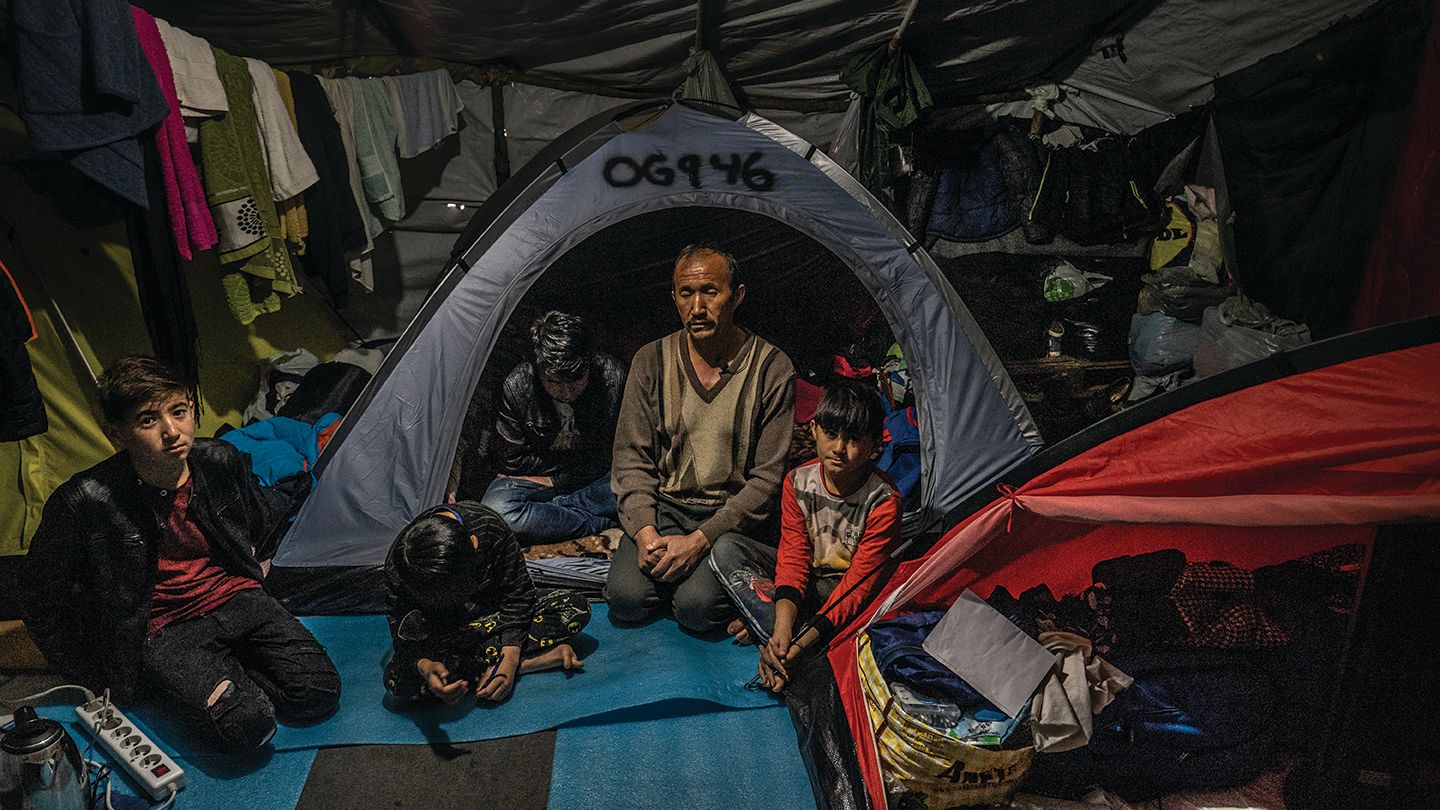
They call them ‘soft signs’ in the paediatric clinic outside Moria, a refugee camp. Bed-wetting is one. ‘We see it a lot,’ says the Italian consultant paediatrician Carola Buscemi who helps run the clinic on Lesvos, Greece, for medical charity MSF (Médecins Sans Frontières).
Then there are the children who have panic attacks in the clinic, as young as six or seven, at least once a week. The babies who stop growing, under the conditions of the camp. ‘This is not normal,’ says Dr Buscemi.
‘These people are completely collapsing. The conditions in the camp are terrible.’
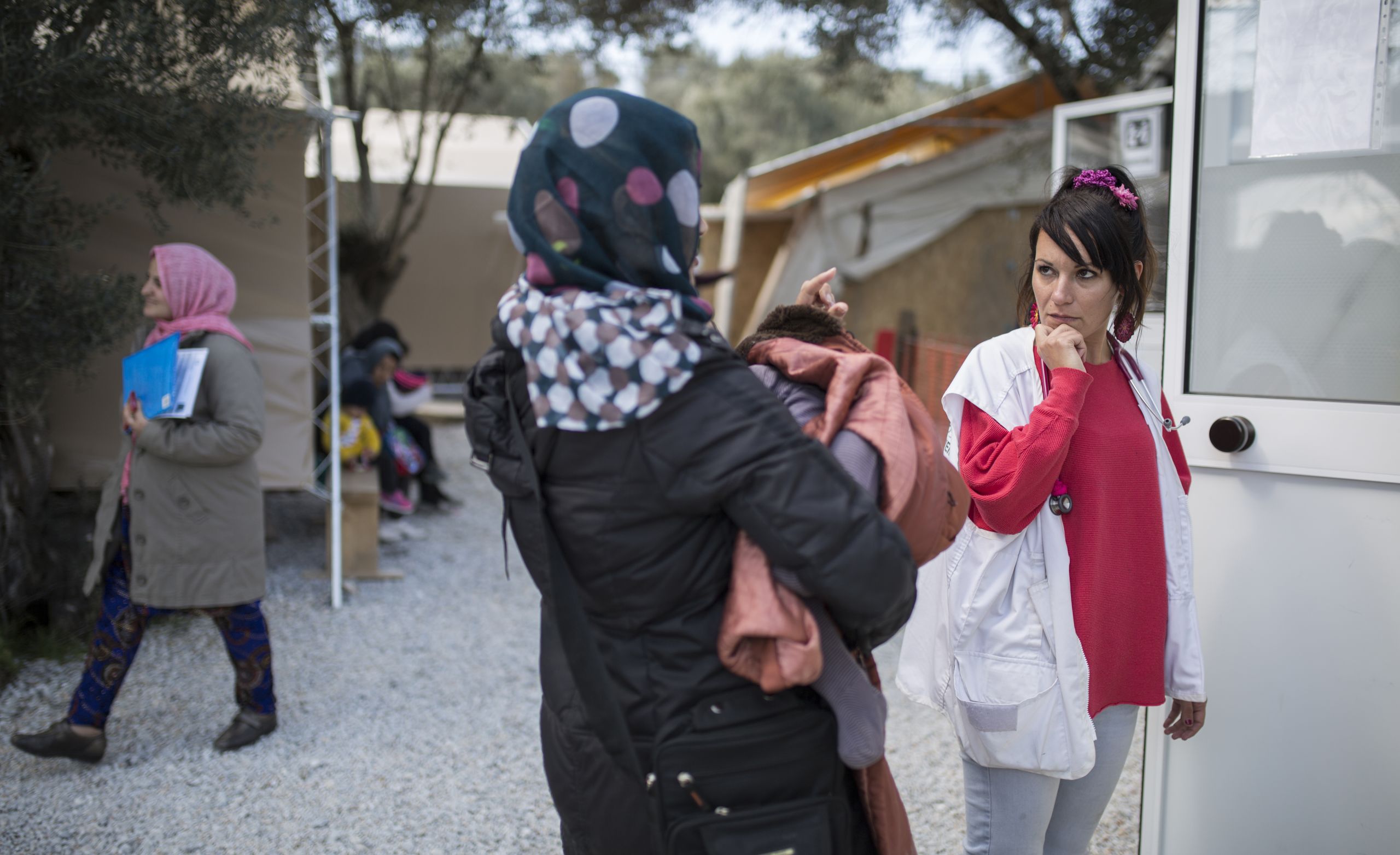
Dr Buscemi with a mother and child in Moria. (Photograph by Socrates Baltagiannis)
Dr Buscemi with a mother and child in Moria. (Photograph by Socrates Baltagiannis)
Yet these and other horrors are the new normality in Moria and other camps, on a chain of Greek islands between Turkey and Europe. Together, they make up a ‘sea border’ on the eastern edge of the continent.
Concerns about the ‘abhorrent conditions’ in camps on two of the islands, Lesvos and Samos, have been raised by MSF and others for years and each year the conditions worsen.
The EU-Turkey deal
The deterioration is linked to a deal between the EU and Turkey in 2016.
So, what is happening in Moria?
How are doctors easing the suffering of the thousands enduring the awful conditions of the camps?
And what is the effect of the EU-Turkey deal?
Under the deal, Turkey received €6bn to take back asylum seekers who arrive in Greece by boat without official permission. To aid these returns, the Greek authorities prevent them from leaving the island, trapping thousands in camps of limited capacity.
The number returned has been far lower than expected, as Greek courts find in favour of refugees’ claims that Turkey doesn’t offer adequate protection.
EU member states including the UK, however, consider the deal a ‘success’ for significantly stemming arrivals and reducing fatalities from perilous sea crossings. Migrants who do still arrive from war-torn countries such as Afghanistan, the Democratic Republic of the Congo and Syria have responded by switching to other routes.
Others, unable to reach European shores, remain scattered. There are millions of displaced people held in limbo in Jordan and the Lebanon. Among the unluckiest are those being held in appalling conditions in Libyan detention centres, vulnerable to extortion, torture, sexual violence, and forced labour.
The dead and missing at sea are still in the thousands, and although numbers of people on the sea are reducing, the UN said last September that one in 18 trying to cross the Mediterranean died en route.
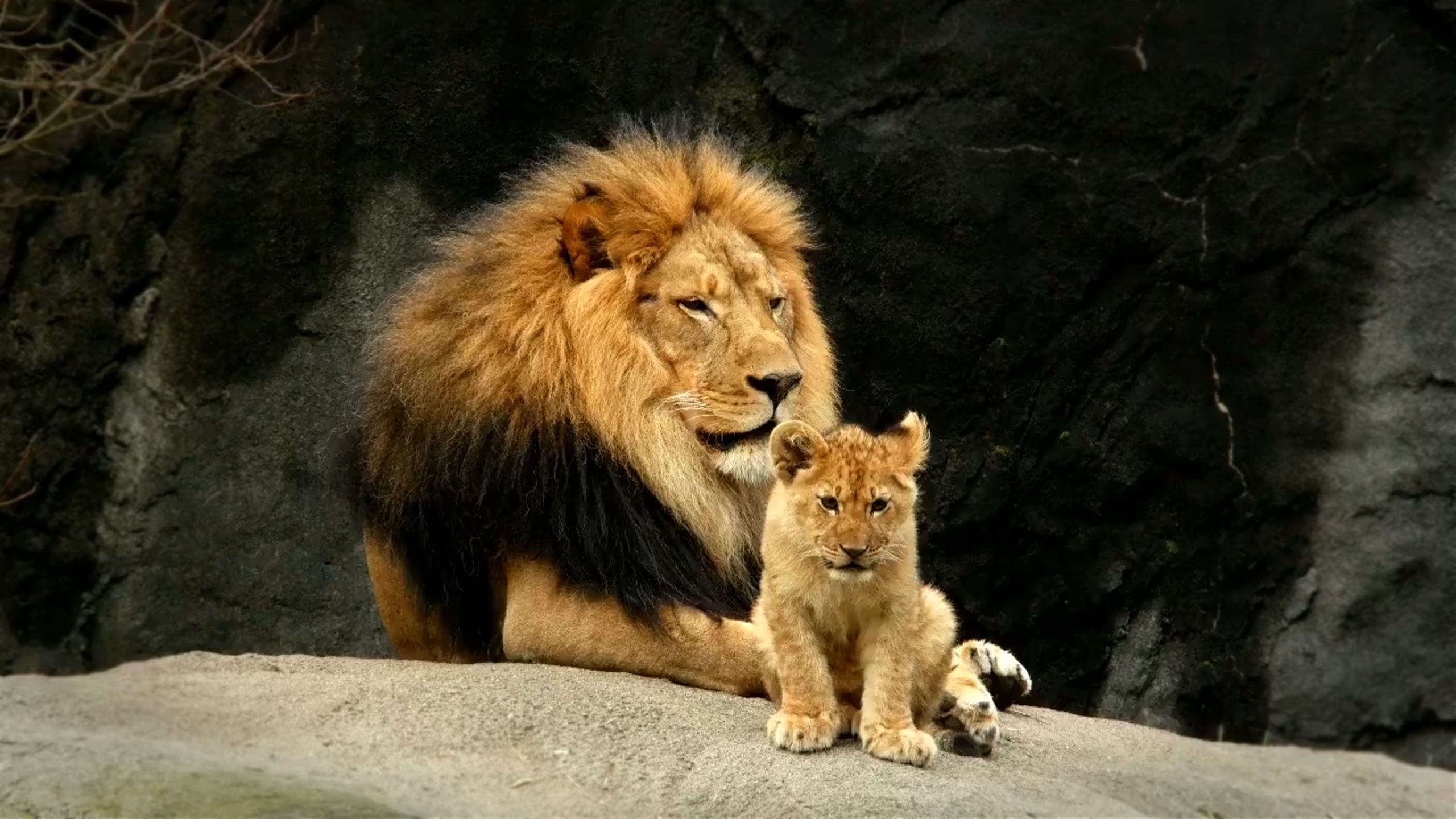
MSF Lesvos field coordinator Caroline Willemen says the EU-Turkey agreement has worsened conditions in the camp, despite the drop-off in arrivals.
‘When people arrived in thousands, they would stay in Lesvos for one or two days before taking the boat to Athens to continue their journeys,’ she says.
‘Now there are fewer people arriving but the impact is much, much worse. You have enormous overcrowding, people living here for one to two years in circumstances that are not acceptable.’
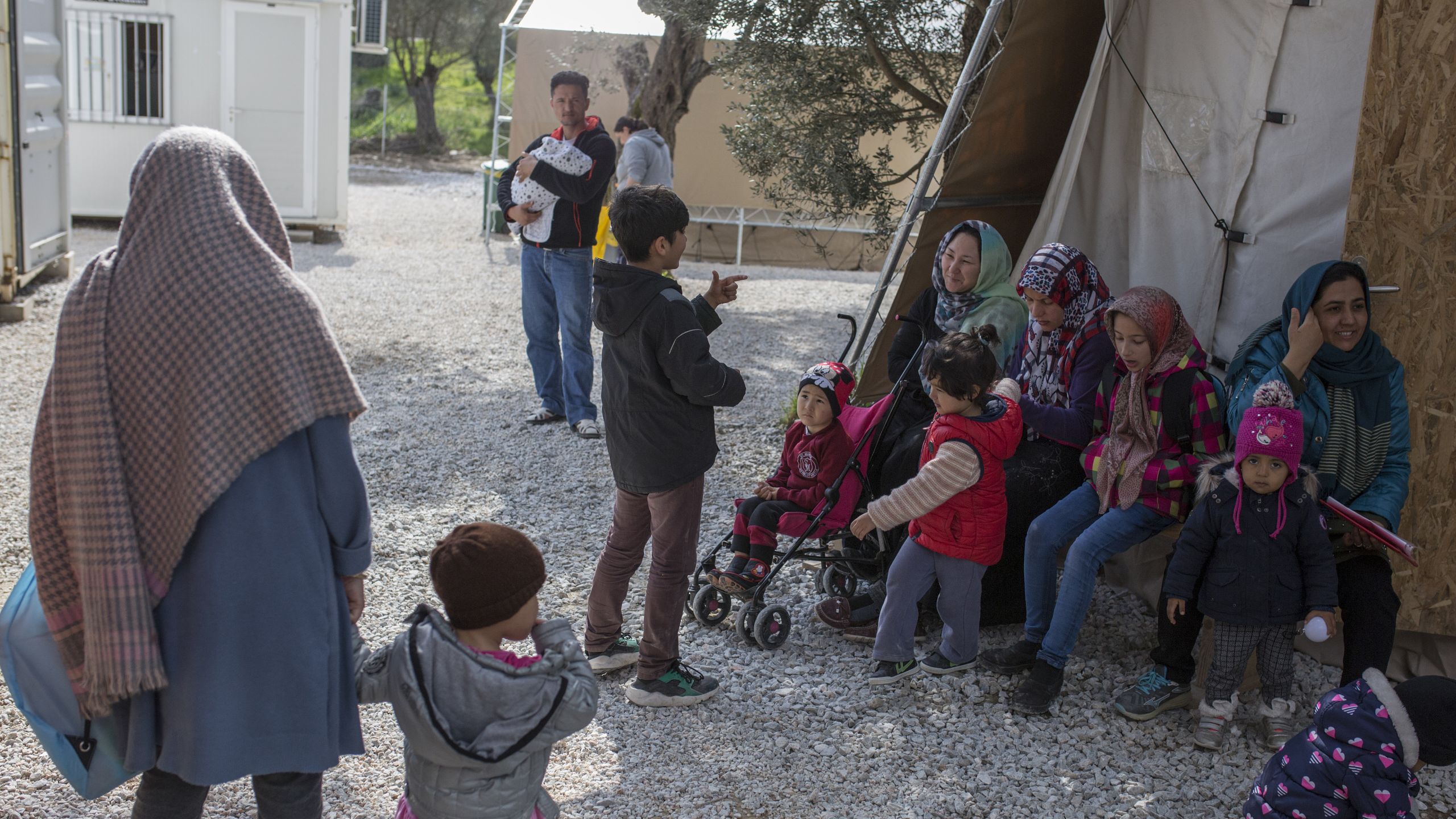
Life in Moria
MSF closed its clinic inside the camp when the deal was signed and no longer takes funding from the EU or its member states. ‘We want to provide care to those who need it most; not be influenced by political actors,’ Ms Willemen says. The vast majority of its income comes from private donors.
The paediatric clinic is now in a medical compound, across the street from the high walls and barbed wire fences of Moria. Through a gate in the compound’s chain-link fence, you arrive at shipping containers, prefab buildings and tents, families standing around, children clambering over wooden benches, whiling away time.
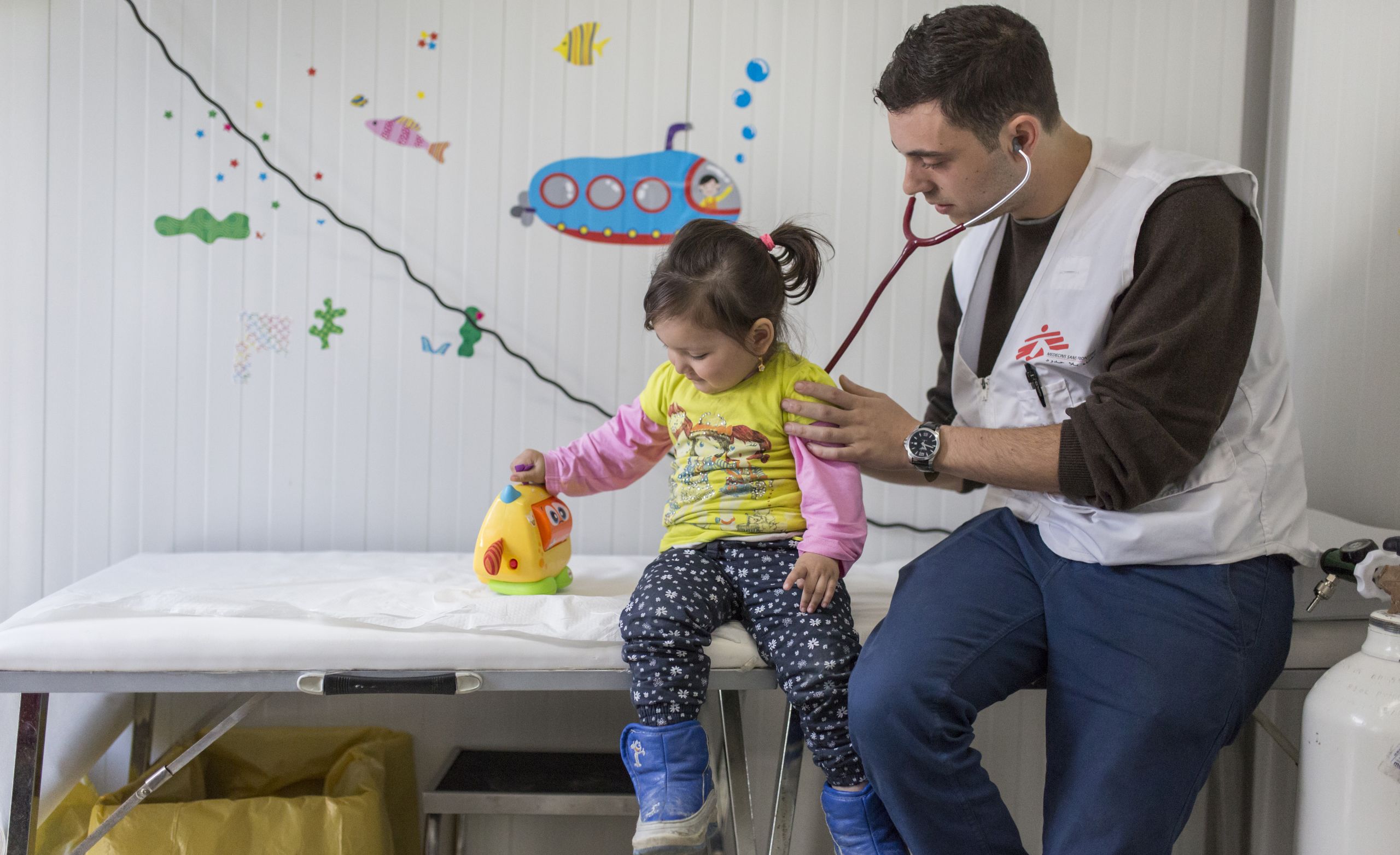
Dr Alexakis sees Afghan refugee Sahar Yaqubi, aged two. (Photograph by Socrates Baltagiannis)
Dr Alexakis sees Afghan refugee Sahar Yaqubi, aged two. (Photograph by Socrates Baltagiannis)
It’s 10am and Leonidas Alexakis, a junior doctor who grew up in Belgium and trained in Thessaloniki, sits at a plastic picnic table in a prefab hut, questioning parents, scribbling notes.
First in today is a two-year-old asthmatic, recovering from a chest infection. Next, a young man arrives in flip-flops with a sore toe. It’s examined, cleaned, dressed and antibiotics are dispensed from the on-site pharmacy. Dr Alexakis consults a colleague, Dr Buscemi, about an opening in the neck of a young girl, which weeps – an infection risk. She agrees it’s a thyroglossal cyst.
In the UK there would be a straightforward surgical solution, but in the camp, there is the perennial problem of limited access to washing facilities for patients to keep wounds clean after surgery.
Women and girls fear walking to the washroom at night.
You can’t enter the official camp, a former military base, without a permit but you can peer in from a hillside. There are staircases of terraced pre-fab accommodation, toilet blocks, families walking together, children dashing down a steep concrete slick, a main street of sorts.
Conditions inside are tough, parents at the paediatric clinic tell us. ‘We live in an Isobox [a prefab block], sharing it with other people. It makes it really difficult to support her,’ one mother attending the clinic with her two-year-old daughter tells us. ‘Almost all the time, she is sick. It doesn’t feel safe.’
It can take hours to queue for meals, piling further stress on families with sick children. Many come to the clinic with scabies and lice.
‘We live in an Isobox, sharing it with other people. It makes it really difficult to support her,’ one mother attending the clinic with her two-year-old daughter tells us. ‘Almost all the time, she is sick. It doesn’t feel safe.’
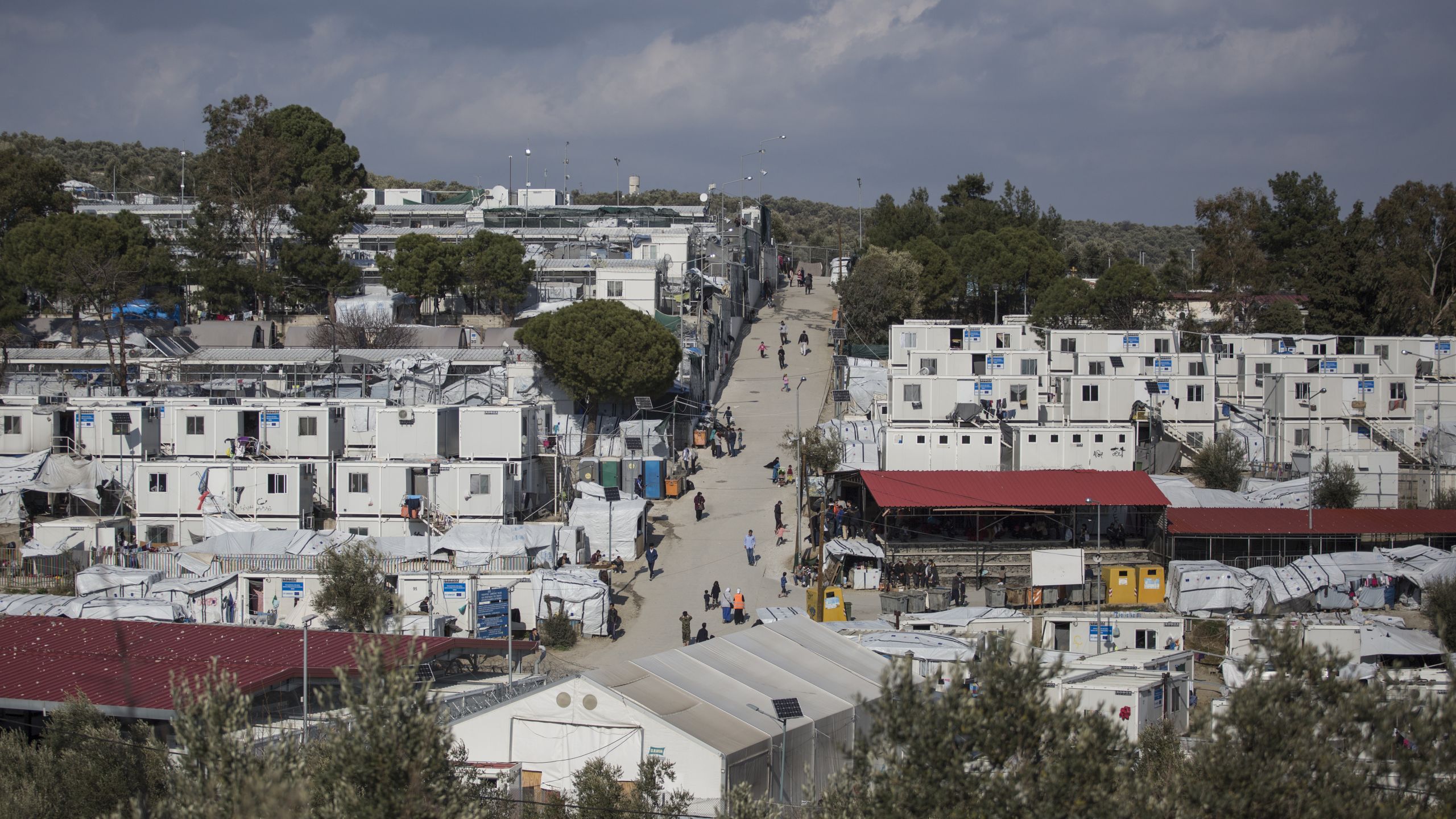
The Olive Grove
If conditions are bad in the old military base, they’re much worse in the Olive Grove, an unofficial overspill, where refugees live and sleep in tents, amid the mud and gnarly trees. The official camp’s capacity is 3,100 but almost 5,000 were living here and in the Olive Grove in March.
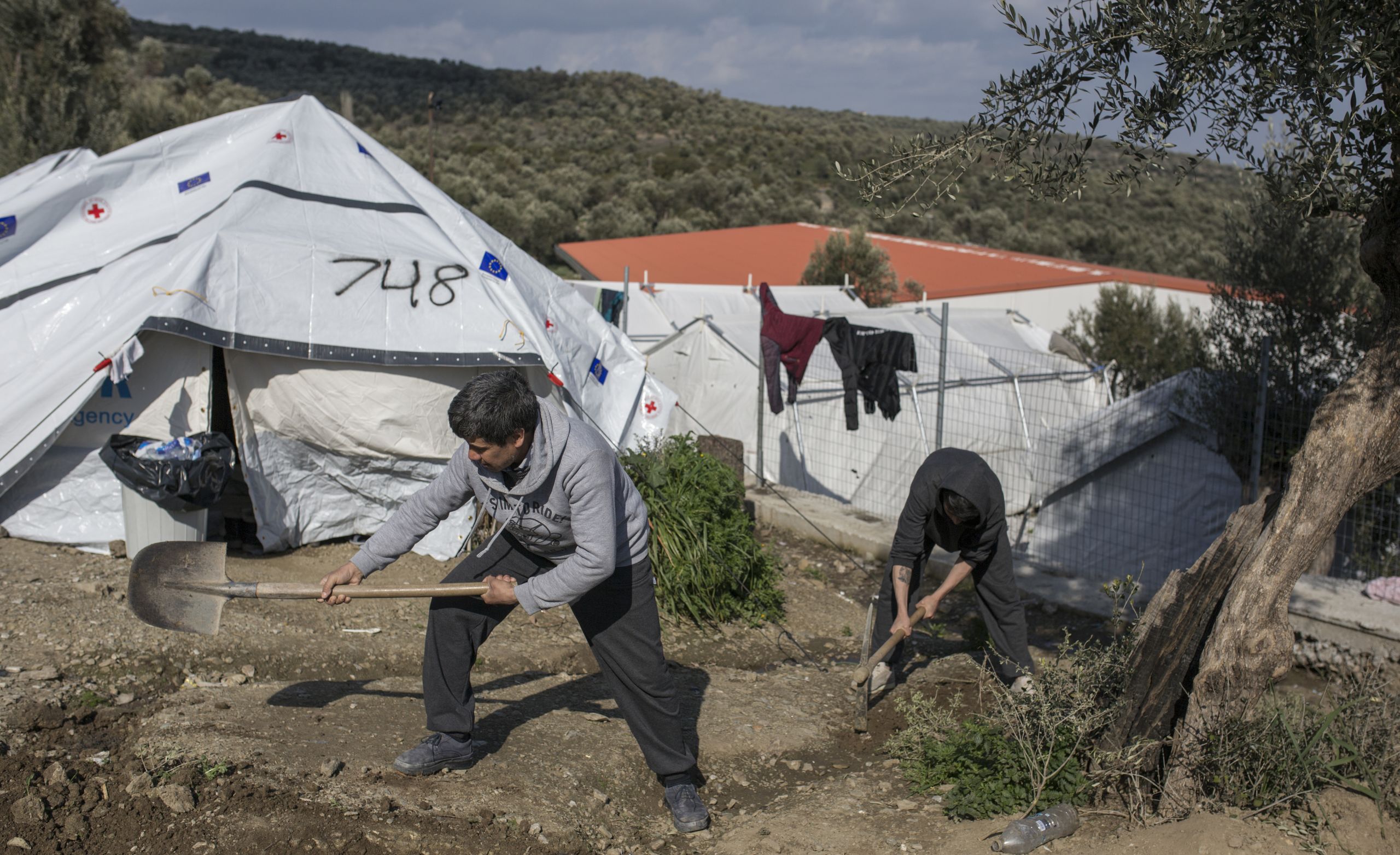
Two men flattening the ground to make room for more tents in the Olive Grove. (Photograph by Socrates Baltagiannis)
Two men flattening the ground to make room for more tents in the Olive Grove. (Photograph by Socrates Baltagiannis)
Conditions worsen with rising numbers, of course. It’s low season now, after months of reduced crossings through winter. However, last summer, the population rose to 8,000, and doctors in the paediatric clinic spent time stitching together the self-inflicted cuts of young men and women.
MSF provides individual and group therapy to help children to cope with the stress, and classes for parents to help spot the signs.
Heavy rain turned the Olive Grove into a muddy bog last winter.
Newborns were found by the charity Oxfam to be sleeping in tents. Today, the mud’s turned to dust, spraying as the ground is flattened to prepare for more arrivals. It’s littered with rocks, bottle caps, the rusting hulks of wood burners.
We find a family, recently arrived from Afghanistan, with a small baby. ‘No electricity. Not good for the children,’ one of their party says.
MSF employs three social workers who can seek alternative accommodation for families which come to their attention, when women bring babies to clinics or see midwives for antenatal appointments. ‘You could question why it is necessary for us to intervene,’ says Ms Willemen.
‘Why is it not obvious to every single person that a newborn and a mother who just gave birth shouldn’t be living in a tent?’
They struggle more to find alternative accommodation for less obvious cases, Ms Willemen adds, such as men who are physically strong but victims of torture, from war zones, who are suicidal. ‘It’s important not to forget that group,’ she says.
MSF struggles to convince accommodation providers to take such people in.
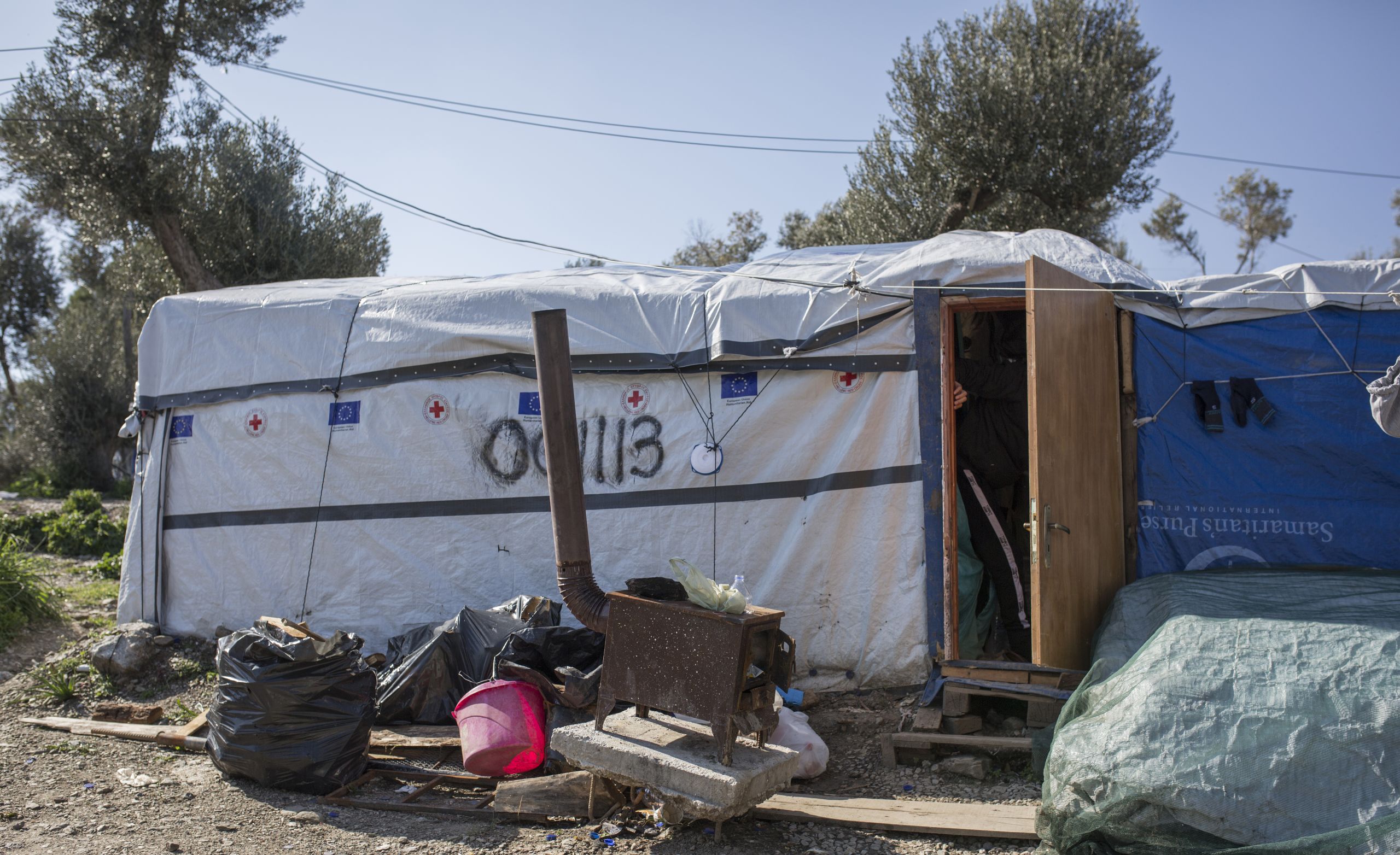
A burnt out wood burner outside a tent in the Olive Grove (Photograph by Socrates Baltagiannis)
A burnt out wood burner outside a tent in the Olive Grove (Photograph by Socrates Baltagiannis)
‘We argue that putting them in a better place will vastly reduce the risk of suicide,’ she says. ‘They will argue – and to an extent I understand – that they don’t have the staff to support them.’
To help this group, the charity set up in late 2017 a mental health clinic in a suburb of Mytilene, the capital of Lesvos. It’s run by medical activity manager Elizabeth Clark – a Luton GP. Referrals come in via email from other medical NGOs (non-governmental organisations) on the island, such as the Boat Refugee Foundation, a Dutch one and the UK-based Kitrinos Healthcare.
It only sees victims of torture, violence or sexual violence, but there are not many in Moria who haven’t had such experiences, Dr Clark says.
‘The referrals we get are people screaming through the night. Not able to wash or dress. Not eating. Putting stones in their mouths. Walking into the woods with a rope.’
They often arrive with a carer. ‘They can cower under the sink, they’re so fearful. They’re dissociating. They think they’re back where they’ve been tortured.’
Their trauma often comes in layers, including the one added by the conditions of the camp. ‘There’s trauma in their country of origin, their journeys, then there’s the environment,’ Dr Clark adds.
‘There’s the fences, the barbed wire, the police going around in Moria, sometimes in riot gear. The noise. The queues for food.’
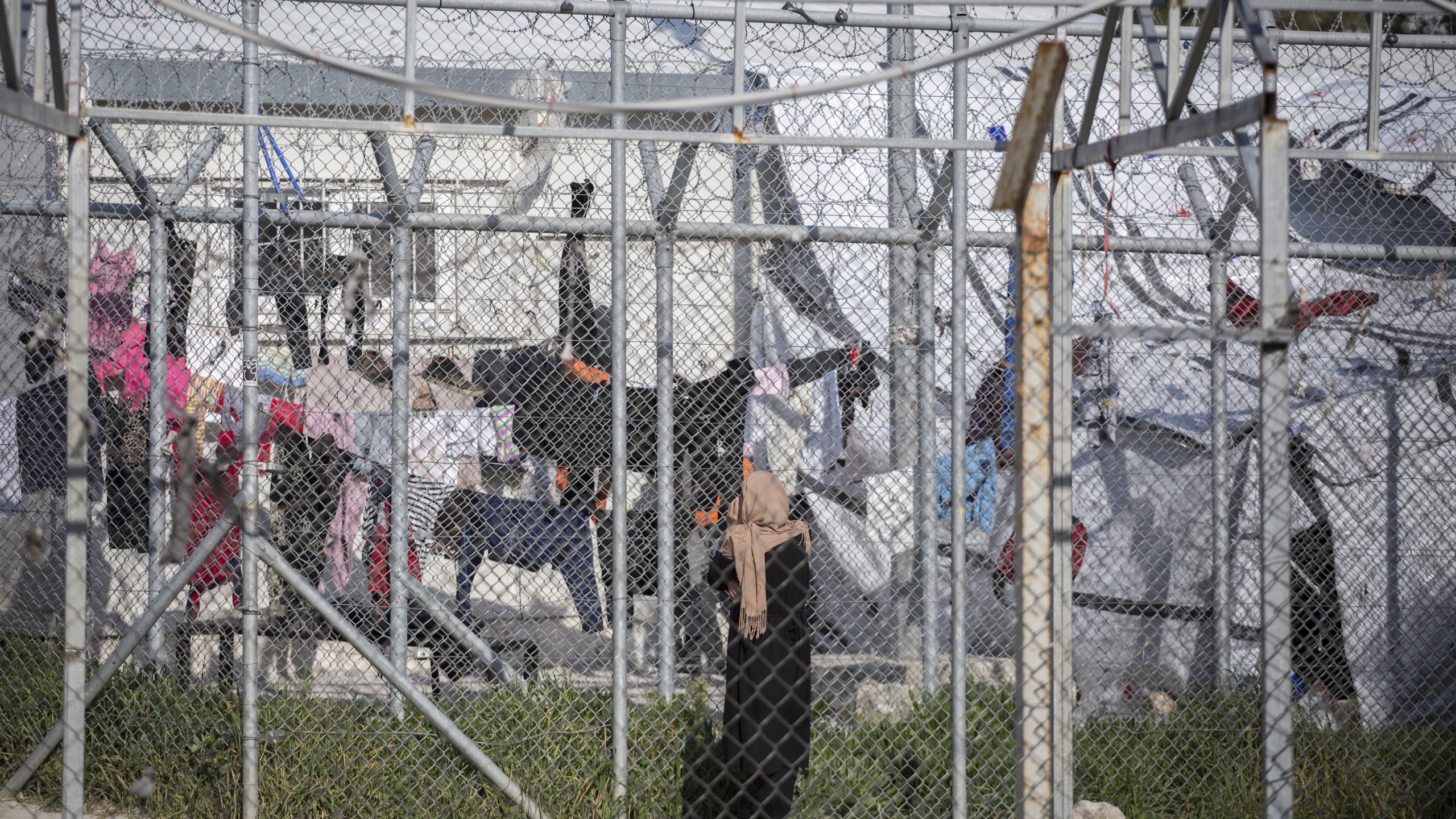
No hope
The most complex cases are seen by Alessandro Barberio, a Rome-trained psychiatrist, born in Bari, Puglia, at the top of Italy’s heel. His patients’ symptoms are not unlike those of schizophrenia, he says, but their conditions are not chronic but ‘reactive’.
‘Here, there’s a concentration of the worst determinants for mental health diseases,’ he says.
‘The environment, the lack of hope, the lack of a possibility to improve, the impossibility of empowerment. Then, there’s past history and trauma.’
He uses the word ‘horror’ a lot to describe the experiences he hears. ‘All of our patients are in a different state of mind. Confused, disoriented, terrorised, scared, anguished, hallucinating. During a session, someone might be looking around, asking, you don’t see it? What, are you not afraid? You don’t see my brother, decapitated.
‘They can smell, also, the blood. It’s always a horror, the violence, the torture. Every time, I feel touched and surprised. Maybe the moment I don’t feel anything, I will leave.’
Dr Barberio talks about his experiences in Moria and his ‘Casablanca’ model of care.
Dr Barberio talks about his experiences in Moria and his ‘Casablanca’ model of care.
Dr Barberio recalls the first time he visited Moria, last year. ‘It was overwhelming. There were these contradictions. A lot of people in makeshift tents, this very particular smell. But also a lot of vitality. Children playing in the dust, the dirt.
‘There is still something so vital about these people. They try to survive.’
The clinic aims to stabilise patients, so they can survive in the camps. For the first weeks, they attend several times a week, are treated by a multidisciplinary team, including doctors and psychologists, and given small amounts of drugs.
They hook patients up with social activities, such as language classes and sports, run by other NGOs or local organisations, such as Shower Power, which providers showers so women can wash in safety. It’s part of its ‘bio-social’ approach and has had surprising success.
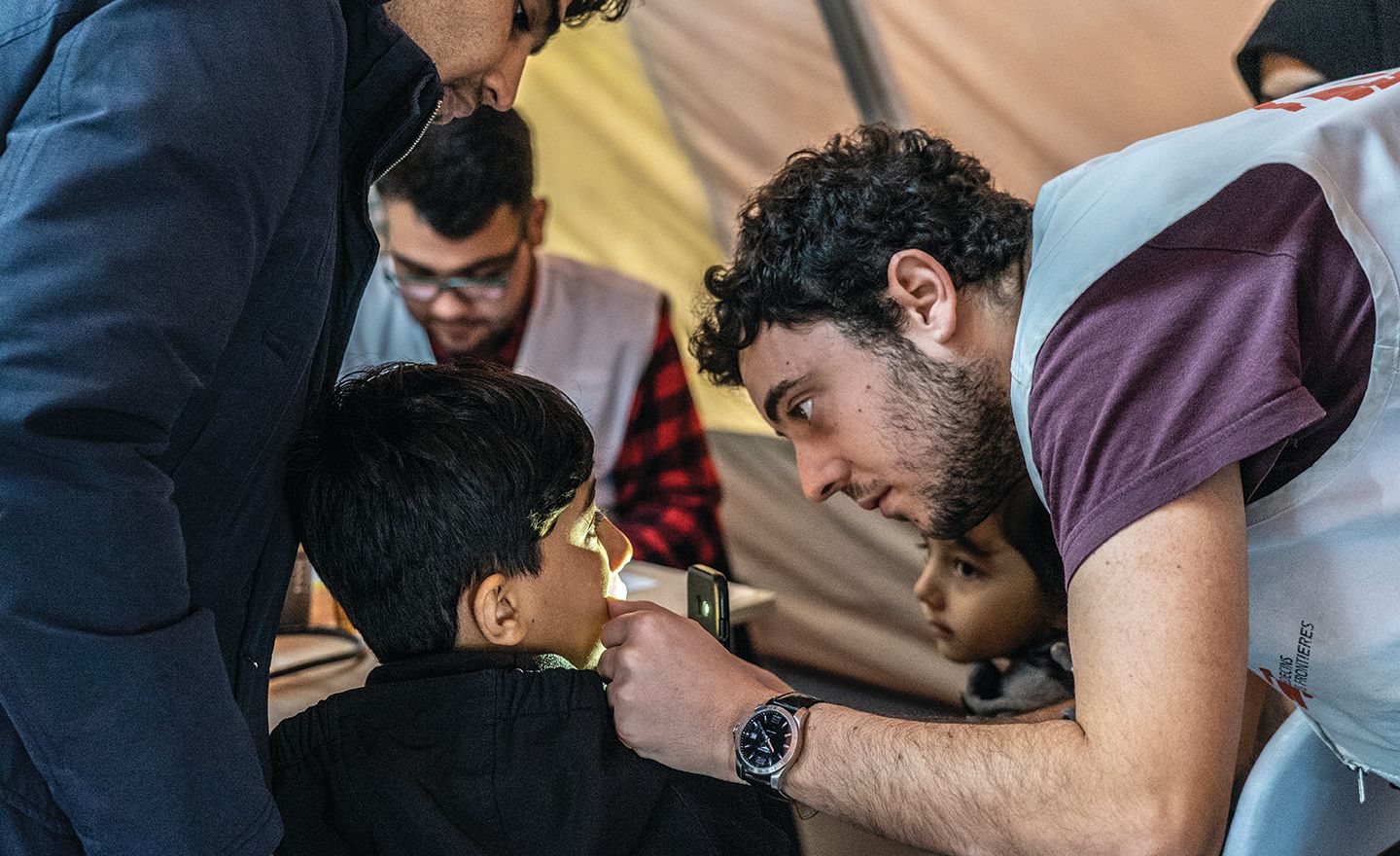
Dr Alexakis treats a patients in Moria. (Photograph by Anna Pantelia/MSF)
Dr Alexakis treats a patients in Moria. (Photograph by Anna Pantelia/MSF)
‘There can be a very dramatic improvement in their symptoms,’ Dr Clark says. ‘We try to build trust that here is a safe place. That here, nobody can hurt them. It’s fabulous to see them improve but we’re only dealing with the few at the top of this iceberg in Moria.’
It’s making a difference that seems to keep these doctors and MSF staff. ‘We are doing a good job,’ Dr Barberio says. ‘But there is also a kind of sadness. There is this collective trauma. Nothing is changing in Europe and that is our future.’
A political stalemate
Ms Willemen knocks on the table when asked if Moria really is the worst refugee camp on earth, as the BBC once described it.
‘Somehow this feels different,’ she says. ‘I’ve worked in Nepal, after the earthquake. I’ve seen some bad things. But that was force of nature. Here, it’s purely politics. It’s the EU wanting to somehow push migrants towards their border. Somehow you feel personally complicit. It’s my part of the world.’
Dr Clark talks of her defence mechanism. ‘I just repeat to myself: there are lots of people, doing lots of small good things. People are good.’ She’s glad she doesn’t have to visit the Moria camp much. She doesn’t want to. ‘I just feel this thing, coming up inside of me,’ she says, raising her arms to her stomach.
‘We moan at Donald Trump and his Mexican borders. But it’s the same.’
It seems personally affecting to care for people, children and tortured adults, in an overcrowded camp where many live in tents and the mud in a corner of Europe to which they feel connected.
With winter at an end, they brace for spring and summer, when arrivals rise, trapped on the island by the EU-Turkey deal – and conditions in this already overcrowded camp inevitably worsen once more.
‘But there is also a kind of sadness. There is this collective trauma. Nothing is changing in Europe and that is our future.’
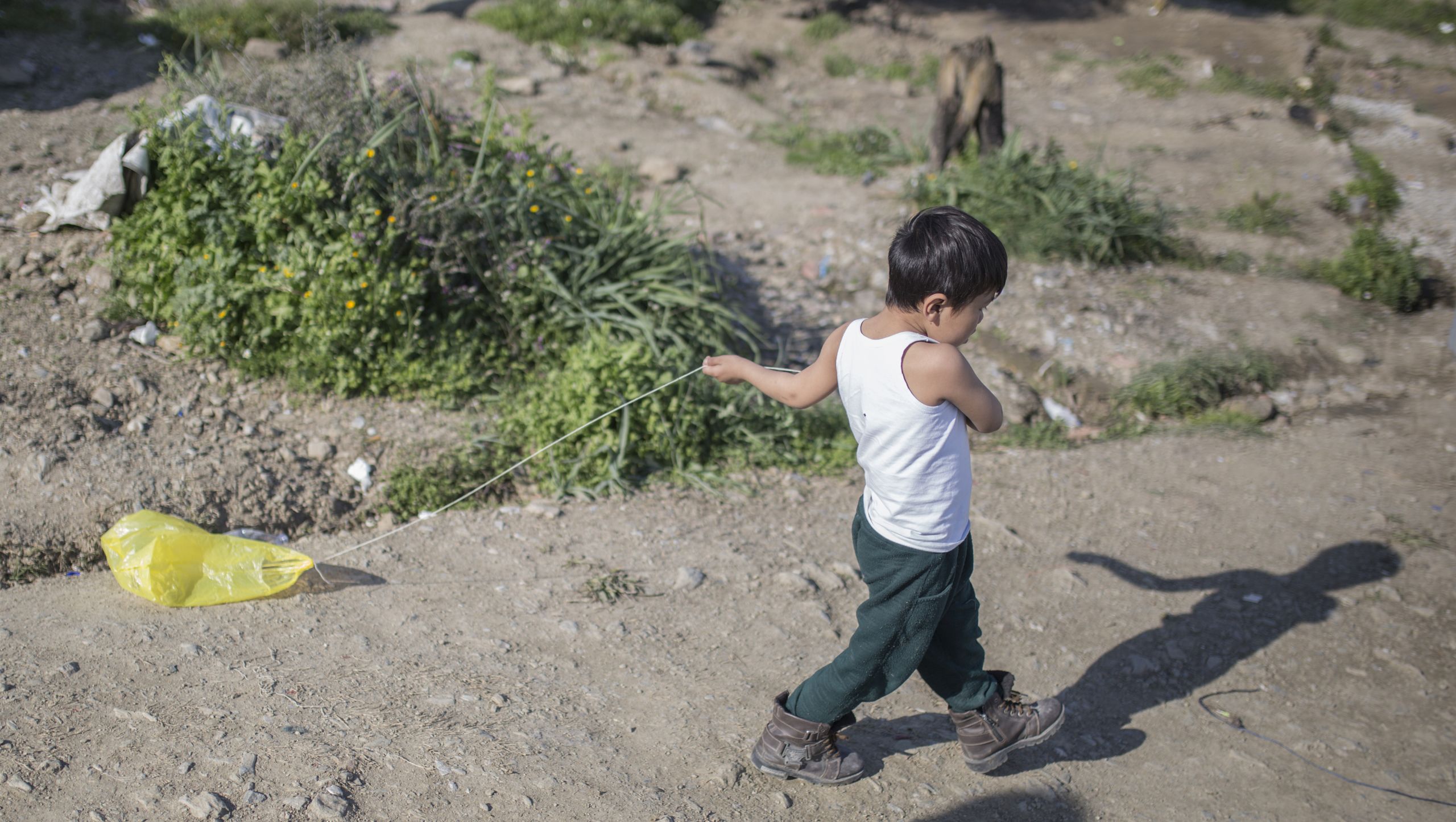
Humanity let down by its leaders
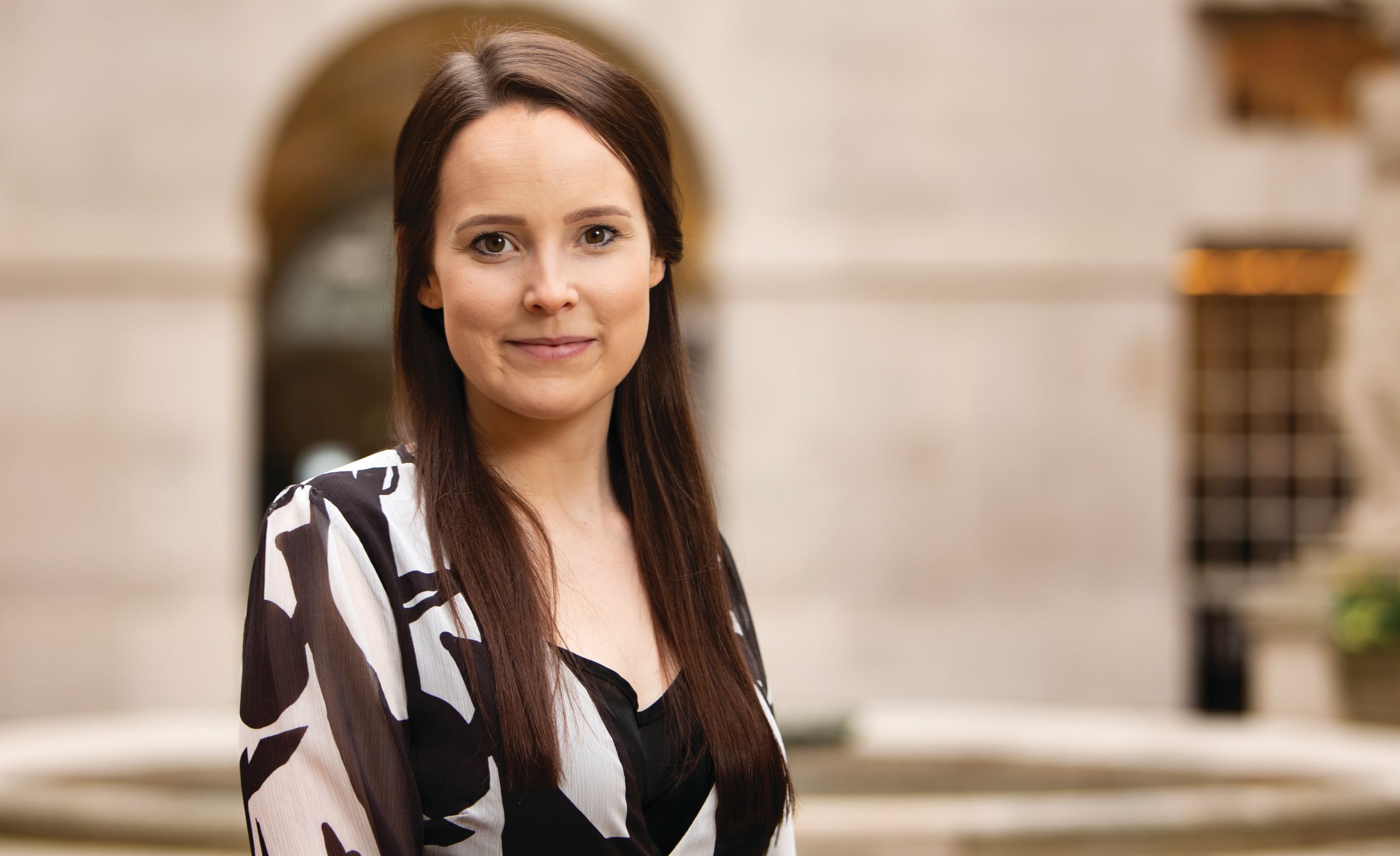
Charlotte Wilson, BMA senior policy adviser (ethics and human rights)
Charlotte Wilson, BMA senior policy adviser (ethics and human rights)
Asylum seekers have been let down by Europe’s failure to agree on an equitable way to handle forced migration, says BMA senior policy adviser (ethics and human rights) Charlotte Wilson.
The humanitarian crisis occurring on Lesvos is not a natural disaster – it is the inexorable outcome of a terrible political stalemate.
When refugee and asylum seeker arrivals to Europe peaked in 2015, flawed EU immigration policies saw member states on Europe’s borders – including Greece – become legally responsible for processing and absorbing a disproportionate number of asylum claims.
Repeated calls for reform to enable the equitable distribution of asylum seekers across the EU have come to nothing. Although there are some EU states who support equitable distribution – believing that the EU should work collectively to meet obligations voluntarily assumed under the Refugee Convention – other states argue that they should not be obligated to accept third-country citizens.
To date, the EU has failed to reach agreement on this issue, and as negotiations have dragged on, border countries have become overwhelmed.
With no resolution in sight, the EU has focused on implementing policies which prevent refugees and asylum seekers from reaching Europe. One such policy is the EU-Turkey deal, others include the construction of razor wire fences through the Balkans, and an agreement between Italy and Libya whereby Italy has agreed to finance, train, and equip Libya’s coastguard – increasingly indistinguishable from militias – to prevent migrant boats from leaving Libya to reach Italy via the Mediterranean.
The EU has also created the ‘Partnership Framework’, a programme which incentivises countries of origin and transit countries to prevent refugees and asylum seekers from leaving by (among other things) making development aid contingent on the improvement of border controls. Some of the countries involved in this partnership include, for example, Eritrea and Sudan, whose leaders have been accused of committing crimes against humanity.
With the focus on preventing refugees and asylum seekers from reaching Europe, the migration narrative has changed course. It has become easy to paint refugees and asylum seekers as a ‘problem’ or a ‘threat’. The language of human rights and human experience is often lost in this context.
Like much contemporary public discourse, the immigration debate is awash with misinformation – in this case, about the scale and effects of immigration (which the evidence shows, are largely positive) as well as the financial and administrative capacity of EU member states.
Surveys reveal that Europeans consistently overestimate the number of asylum seekers and refugees that live in their countries, and in many EU states – for example in England, Wales, and Italy – the public tend to have negative views of forced migrants, believing that they are more likely to commit crimes. However, the evidence shows that this is not the case.
In England and Wales, foreign nationals make up 11 per cent of the prison population, almost exactly in line with their proportion of the population (13 per cent). In Italy, crime statistics demonstrate that crime rates have decreased, including amongst foreign residents and in areas which host large numbers of refugees and asylum seekers.
Europeans also tend to believe that refugees and asylum seekers place strain on public resources.
However, a recent analysis of the impacts of ‘inflows’ of asylum seekers on 15 western European countries over a 30-year period found that contrary to popular belief, inflows have not had a negative impact on host countries’ economies.
Instead, inflows have been found to increase per capita GDP and improve the balance of public finances. This is because increases in public expenditure have been outweighed by a corresponding increase in tax revenues.
Nevertheless, politicians and the mainstream media have been quick to capitalise on the anxieties which surround immigration, perpetuating misperceptions for political or financial gain and causing them to become further entrenched.
As a result, public opinion has swung firmly against immigration – which will undermine the success of evidenced-based immigration policies in the future. This is a chilling prospect, as forced migration is set to increase, and will almost certainly be a defining issue of the 21st century.
Story by Keith Cooper

